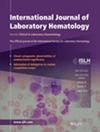Disseminated Intravascular Coagulation in Pediatric Acute Leukemia: Prevalence, Laboratory Features, and Prognostic Significance of ISTH Score
Abstract
Introduction
Disseminated intravascular coagulation (DIC) is associated with acute leukemia. DIC prevalence and clinical consequences are complex and varies across acute leukemia subtypes. The International Society of Thrombosis and Hemostasis (ISTH) scoring system is used for the detection of overt DIC.
Methods
Children of both sexes (1 day-18 years) with acute leukemia, suspected to have DIC and referred to hematology laboratory were included in the study. DIC score was calculated according to ISTH guidelines from laboratory values obtained within 24 h of admission and repeated after 2 weeks. The DIC cases were classified into overt DIC if ISTH score ≤ 5 and non-overt if ISTH score > 5.
Results
Sixty-two children diagnosed with acute leukemia and having the clinical and laboratory diagnostic features of DIC along with 48 age-matched healthy controls participated in the study. DIC was more frequently diagnosed in cases of AML (66.13%) compared to ALL (33.87%). Cases with T-ALL had DIC (19.4%) more frequently than B-ALL type (14.5%). Similarly, children with M5, M2, and M3 had DIC more frequently (16.1%, 15.58% and 14.28%, respectively) compared to other AML types. Overt DIC was observed in 71% of DIC cases with acute leukemia while non-overt DIC was diagnosed in 29% of them. Follow-up for 14 days of non-overt cases showed that 12 out of 18 patients progressed from non-overt to overt DIC with a significant increase in D-dimer and a decline in platelets count. The incidence of bleeding (35.4%) was higher than thrombosis (19.4%) among acute leukemia patients with DIC. An ISTH score ≤ 5 predicted increased intensive care unit (ICU) admission, death and end organ dysfunction with odds ratio of 4.28, 6.77, and 6.67, respectively. Based on receiver–operator analysis of DIC cases classified as overt and non-overt DIC based on ISTH score, D-Dimer was excellent predictor of overt DIC with the high sensitivity and specificity.
Conclusion
ISTH score predicts death, ICU admission and organ dysfunction in children with acute leukemia. D-Dimer is an excellent predictor of overt DIC in acute leukemia.

 求助内容:
求助内容: 应助结果提醒方式:
应助结果提醒方式:


